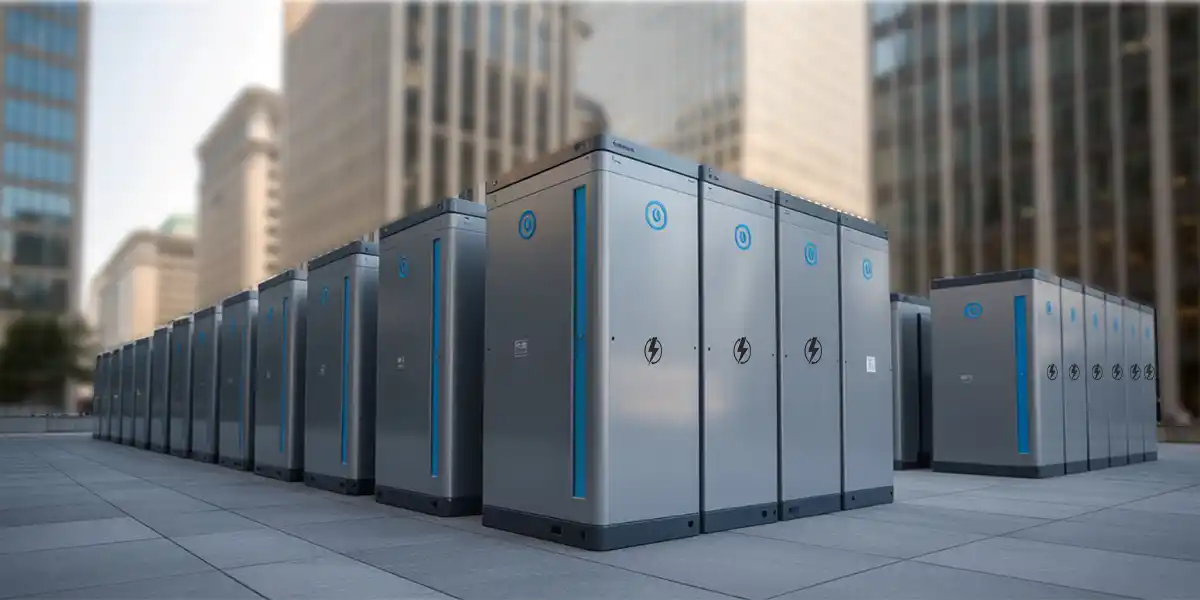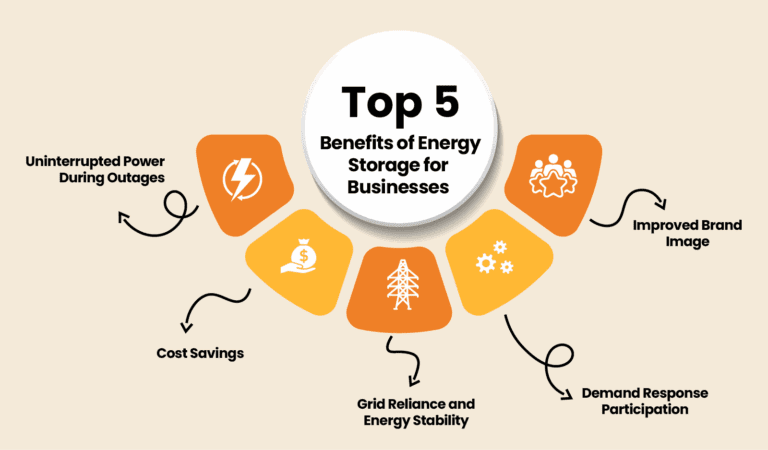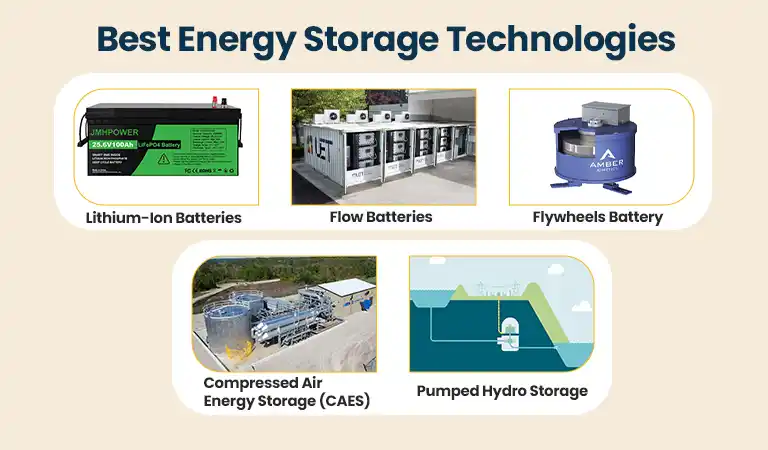- Updated On: September 23, 2025
Energy Storage for Businesses:
What You Need To Know
From reducing peak demand charges to integrating renewable energy sources, energy storage systems offer a multitude of benefits for businesses, ranging from small local companies to international corporations. In today’s rapidly evolving energy landscape, businesses face increasing pressure to reduce costs, enhance sustainability, and ensure they have a reliable power supply. Energy storage is a pivotal tool smart companies are using to address these challenges effectively.

In this article, we will delve into the intricacies of energy storage for businesses, exploring its significance, technologies, benefits, considerations, and future outlook.
Understanding Energy Storage
Energy storage, simply put, means capturing and storing energy for later use. Businesses can use an energy storage system to store excess energy produced by a renewable energy system, or to buy electricity off the grid and store it when demand is low and prices are low. Then the business can use it or even sell it back to the grid when demand and prices are high, thereby optimizing energy storage system usage to reduce utility expenses.
There are several forms of energy storage. They include flywheels, compressed air storage, and pumped hydro storage. Battery storage is the most flexible because of its versatility, portability, scalability, and continually declining costs.
What are the benefits of energy storage for businesses?
Battery storage is essential to the shift away from fossil fuels. In addition to the clear environmental advantages, businesses, municipalities, and utilities across the United States are integrating battery storage with renewable energy systems to lower energy costs and increase energy reliability.

Protection Against Power Outages
Power outages are becoming increasingly common due to extreme weather conditions. This affects businesses’ bottom lines across the country. Also, wages, inventories, output, and sales all severely decline each time the grid goes down. Power outages can have varying financial effects on different types of businesses; nevertheless, for large companies, the cost of an outage can reach millions of dollars for every hour of downtime.
Businesses must integrate an energy resilience plan into their overall business strategy to survive in the upcoming years. Companies that combine energy storage with PV systems can continue to run their business during an unplanned or scheduled power outage.
Lowers Energy Costs
For the energy they utilize, the majority of business utility customers pay on a kilowatt-hour basis. Also, the company’s peak consumption time throughout a single billing cycle determines charges. Billing is applied to companies for surges in use that are above their allotted kilowatt-hours. Peak shaving reduces overall expenses for companies and helps them control demand overall by eliminating temporary spikes in demand. By utilizing the battery during periods of higher energy costs, load shifting enables businesses to adjust their energy consumption. Furthermore, customers can more easily take part in available DR programs with energy storage, as it provides them with the option to lower their site’s grid demand during times of emergency without affecting their electricity usage.
Grid Reliance and Energy Stability
An increasing number of utility consumers are producing their electricity today from renewable sources. All of a sudden, energy begins to flow in different directions. Unfortunately, there are times when peak demand and peak generation from renewables don’t match. Utility operators thus have difficulty during times when too much renewable production enters the grid and there is insufficient load, or insufficient generation to fulfill demand.
The ability of energy storage to improve the grid’s integration of renewable energy is one of its main advantages. By storing extra energy, energy storage may send renewable energy, balancing out its distribution. Additionally, energy storage can adjust load by infusing or extracting electricity as needed when demand changes rapidly or unexpectedly.
Demand Response Participation
Businesses can participate in demand response programs more effectively with energy storage, where such programs are available. By adjusting their energy consumption in response to grid conditions or market signals, businesses can earn incentives and revenues while supporting grid stability. Energy storage systems can provide quick and precise responses to demand response signals, enhancing the effectiveness of participation and helping to stabilize the grid.Energy storage allows businesses to participate in demand response programs where available. Under these programs businesses can help provide grid stability and generate income by modifying their energy consumption habits in response to market signals or grid conditions. They can choose to reduce their use or send power back to the grid to generate income or offset their use of grid power at other times.
Improved Brand Image
Implementing energy storage systems helps businesses reduce their carbon footprint and environmental impact. By optimizing energy usage, increasing the utilization of renewable energy, and reducing reliance on fossil fuels, businesses contribute to mitigating climate change and promoting sustainability. Energy storage also minimizes emissions associated with backup power generation, either by the business or when the utility must run backup power stations, further enhancing environmental benefits.
Energy Storage Technologies for Businesses

Lithium-Ion Batteries:
Widely used in everything from smart devices to electric vehicles and energy storage systems for data farms and utility substations, lithium-ion batteries offer high energy density, fast response times, and long cycle life.
Flow Batteries:
Flow batteries are generally used in applications where energy density doesn’t matter as much and may become more popular for businesses in the future. They store energy in liquid electrolyte solutions that are cycled by a pump. They offer long-duration storage, and potentially lower costs per kilowatt-hour.
Flywheels:
Flywheel systems store kinetic energy in a rotating mass, providing rapid response times and high-power density for short-duration applications.
Compressed Air Energy Storage (CAES):
CAES systems compress air in underground caverns or containers to store energy, offering large-scale, long-duration storage capabilities. CAES is a potential energy storage solution for large buildings with high energy needs, like data farms, that we may see grow in the coming years.
Pumped Hydro Storage:
Pumped hydro storage involves pumping water to higher elevations during off-peak hours and releasing it through turbines during peak demand periods.
The future of energy storage for businesses looks promising, driven by advancements in solar technology, declining costs, and increasing demand for clean energy solutions. Energy storage will play a crucial role in moving towards a more resilient, sustainable energy ecosystem as renewable energy use continues to rise and grid modernization efforts accelerate.
We’re likely to see more innovations in solid-state batteries, artificial intelligence-driven energy management systems, and novel storage chemistries. These should help lower energy storage costs and make implementing it easier.
To learn how your company can benefit from energy storage and renewable energy, check out how Solar SME can help you or get a FREE Estimate with our smart solar calculator NOW!
Related Articles:
With the increasing demand for solar energy systems, the need for an efficient battery energy storage solution has become important for homeowners.
With frequent long power outages in the United States due to bad weather conditions and grid failures, homeowners are now seeking solutions to protect themselves and reduce their reliance on the power grid.
Due to this growing issue, people now look for alternative power sources. But the common dilemma is solar battery vs generator: which one is best for you? Explore the pros and cons of both options and analyze both on the basis of some major factors!



